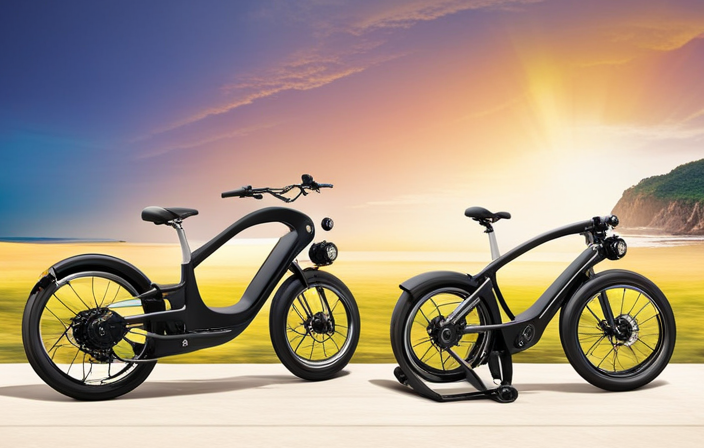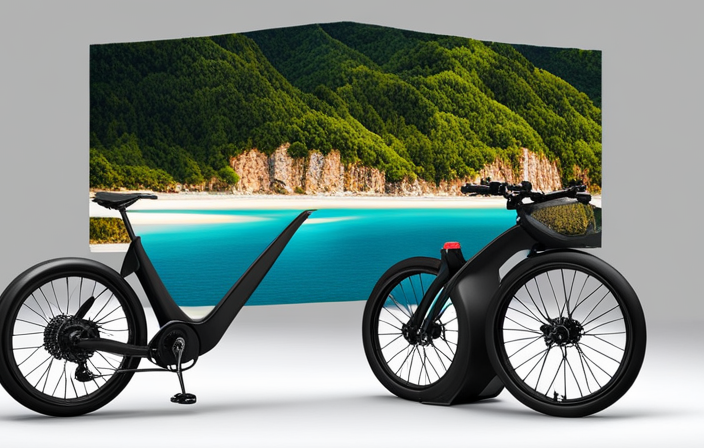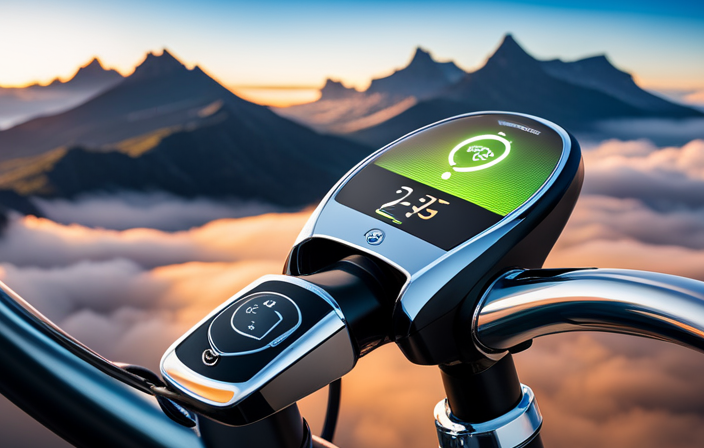Have you ever thought about how much distance you can cover with an electric bike? Well, I have some answers for you.
In this article, we’ll delve into the factors that determine the range of an electric bike, from battery capacity to rider weight and terrain.
We’ll also discuss tips for maximizing your electric bike range and share real-life examples.
So, if you’re ready to hit the road on your electric bike and explore the possibilities, let’s dive in!
Key Takeaways
- The range of an electric bike depends on factors like battery capacity and level of assistance.
- Battery management and maintenance, such as avoiding overcharging or fully depleting the battery, can help maximize the mileage.
- Range extenders and additional batteries can provide extra power and mileage, but they add weight and can be expensive.
- Energy regeneration through regenerative braking can increase energy efficiency and range, contributing to a greener environment.
Understanding the Battery Capacity
The battery’s capacity determines how far you can go on an electric bike. It is essential to understand the battery life and charging time when considering the range of an electric bike.
Battery life refers to how long the battery can provide power to the bike before needing to be recharged. This can vary depending on the battery’s capacity and the power consumption of the bike.
Charging time, on the other hand, refers to how long it takes to fully recharge the battery. It is crucial to consider both factors when planning your rides, especially if you intend to cover long distances.
Consider the Terrain and Elevation
Take into account the type of terrain and elevation you’ll be riding on when estimating your electric bike’s range. The range of an electric bike can vary depending on these factors. Here are a few things to consider:
-
Uphill rides: Riding uphill requires more power from the motor, which can significantly reduce your bike’s range. It’s important to keep this in mind when planning your route.
-
Off-road adventures: If you plan on taking your electric bike off-road, the rough terrain can also impact the battery life. Bumpy trails and uneven surfaces can drain the battery faster than smooth roads.
Considering battery life and researching electric bike models that are designed for the type of terrain you’ll be riding on can help you make an informed decision. By understanding the impact of terrain and elevation on your electric bike’s range, you can choose a model that suits your needs.
When it comes to estimating the range of an electric bike, the weight of the rider and cargo is another crucial factor to consider.
Weight of the Rider and Cargo
Consider factoring in your weight as well as the weight of any cargo you may be carrying when estimating the range of your e-bike. The rider’s fitness level and the impact of cargo weight on the e-bike’s battery life are important factors to consider.
A heavier rider or a heavier load will require more power from the battery to maintain the same speed and distance. If you are carrying a heavy backpack or groceries, it will reduce the overall range of your e-bike.
Additionally, a rider’s fitness level can also affect the range. If you are pedaling along with the electric motor, you will be using less battery power compared to someone who relies solely on the motor.
By taking these factors into account, you can more accurately estimate how far your e-bike will take you.
As we discuss riding style and speed, it is important to understand how these factors can further impact your e-bike’s range.
Riding Style and Speed
Riding aggressively or at high speeds will drain the battery faster. To help you make the most of your electric bike’s range, here are some tips:
-
Optimize your riding technique: By using smooth and gradual acceleration, you can conserve battery power and extend your mileage. Avoid sudden stops and starts, as they require more energy.
-
Consider the impact of wind: Riding against a headwind can significantly affect your range. To minimize its impact, try to find sheltered routes or use your body to create an aerodynamic profile.
-
Use pedal-assist wisely: Utilizing the pedal-assist mode efficiently can help you go further. Find the right level of assistance that balances your effort and battery consumption.
By implementing these strategies, you can maximize your electric bike’s range and enjoy longer rides.
Transitioning into the next section, weather conditions and temperature also play a crucial role in determining the mileage you can achieve.
Weather Conditions and Temperature
To optimize your electric bike’s range, it’s important to be mindful of the weather conditions and temperature. These factors can significantly impact the performance of your electric bike and affect how far you can travel on a single charge.
One key weather element to consider is wind speed. Riding against a strong headwind can cause resistance, making it more difficult for your electric bike to maintain speed and ultimately reducing its range. On the other hand, a tailwind can provide a boost and increase your bike’s efficiency.
Additionally, extreme temperatures can also affect battery performance. In colder weather, the battery’s capacity may decrease, resulting in a shorter range. Similarly, in hot weather, the battery may overheat, leading to reduced performance.
Now, let’s discuss the efficiency of the motor and drive system.
Efficiency of the Motor and Drive System
The efficiency of the motor and drive system can greatly impact the overall performance of your e-bike. Motor efficiency refers to how effectively the motor converts electrical energy into mechanical power. A higher motor efficiency means less energy is wasted, resulting in longer battery life and increased range.
Similarly, drive system efficiency refers to how efficiently power is transferred from the motor to the wheels. A well-designed drive system minimizes energy losses, allowing for smoother acceleration and higher top speeds.
To improve motor efficiency, manufacturers use advanced technologies such as brushless motors and regenerative braking. Drive system efficiency can be enhanced through the use of efficient transmission systems and optimized gear ratios.
By maximizing both motor and drive system efficiency, you can get the most out of your e-bike, enjoying longer rides and extended battery life.
Speaking of efficiency, another important factor to consider is tire pressure and rolling resistance.
Tire Pressure and Rolling Resistance
Don’t forget to check the tire pressure on your e-bike regularly to minimize rolling resistance and improve overall efficiency. Maintaining the correct tire pressure is crucial for maximizing the benefits of your electric bike.
When the tire pressure is too low, the contact area between the tire and the road increases, resulting in higher rolling resistance. This means that you need to exert more effort to keep the bike moving, ultimately reducing your battery life. On the other hand, if the tire pressure is too high, it can lead to a harsh and uncomfortable ride.
By finding the right balance and keeping the tire pressure at the recommended level, you can decrease rolling resistance, conserve battery power, and enjoy a smoother ride.
Now, let’s explore the benefits of using pedal assist or throttle only.
Use of Pedal Assist or Throttle Only
Using pedal assist or throttle only can greatly enhance your riding experience on an e-bike. When it comes to choosing between pedal assist and throttle control, it’s important to consider the impact of your physical fitness. Pedal assist utilizes a sensor that detects your pedaling motion and provides assistance accordingly. This option is ideal for riders who want to get some exercise while still enjoying the benefits of electric assistance. On the other hand, throttle control allows you to simply twist the throttle and let the motor do all the work. This is a great option for those who may have limited physical fitness or simply want a more relaxed ride.
| Pedal Assist | Throttle Control |
|---|---|
| Requires pedaling | No pedaling required |
| Provides assistance based on pedaling | Motor provides constant assistance |
| Ideal for exercise and fitness | Great for relaxed rides |
Battery Management and Maintenance
To ensure optimal performance and longevity of your battery, it’s important to regularly check its charge level and follow recommended maintenance guidelines. Proper battery management is crucial for maximizing battery lifespan and getting the most out of your electric bike.
One key aspect of battery management is monitoring your charging habits. It’s recommended to avoid overcharging or fully depleting the battery, as this can negatively impact its lifespan. Instead, aim to keep the battery charge level between 20% and 80%.
Additionally, storing the battery in a cool, dry place when not in use can help preserve its overall health. By following these battery management practices, you can extend the life of your battery and enjoy longer rides on your electric bike.
When it comes to extending the range of your electric bike, there are options available such as range extenders and additional batteries.
Range Extenders and Additional Batteries
There’s an option to increase the range of your e-bike by using range extenders or adding extra batteries. Range extenders are devices that can be attached to your electric bike to provide additional power and increase your mileage. On the other hand, adding extra batteries involves installing an additional battery pack to your e-bike. Let’s take a look at the pros and cons of each option:
| Range Extenders | Additional Batteries |
|---|---|
| – Easy to install | – Provides significant increase in range |
| – Can be used with any e-bike | – Allows for longer rides without recharging |
| – Provides a boost in power and speed | – Can be expensive |
| – Doesn’t add much weight to the bike | – Adds additional weight to the bike |
While range extenders are a convenient option for quick and easy installation, adding extra batteries can give you a significant increase in range. However, it’s important to consider the added weight and cost when making your decision. Now, let’s explore another way to maximize the range of your e-bike through energy regeneration and braking techniques.
Energy Regeneration and Braking Techniques
After exploring the concept of range extenders and additional batteries in the previous section, let’s delve into another important aspect of electric bike efficiency: energy regeneration and braking techniques.
As an electric bike enthusiast, I’ve come to appreciate the benefits of regenerative braking firsthand. Here are four key points to consider:
-
Regenerative Braking: This innovative technology allows the electric bike to convert kinetic energy into electrical energy when braking, which is then stored in the battery for later use.
-
Increased Energy Efficiency: By harnessing the power of regenerative braking, electric bikes can achieve higher energy efficiency, maximizing the range you can get on a single charge.
-
Extended Battery Life: Regenerative braking not only saves energy but also reduces wear and tear on the brakes, resulting in a longer lifespan for both the battery and braking system.
-
Environmental Impact: By utilizing regenerative braking, electric bikes contribute to a greener environment by reducing energy waste and decreasing the need for fossil fuel consumption.
With a solid understanding of energy regeneration and braking techniques, we can now move on to the next section, where we will discuss how to choose the right electric bike model for your needs.
Choosing the Right Electric Bike Model
When selecting an electric bike model, it’s important to consider factors such as your riding preferences, terrain, and desired level of assistance. To help you make an informed decision, let’s compare some popular bike models and their battery range calculations. Take a look at the table below:
| Model | Riding Preferences | Terrain | Level of Assistance |
|---|---|---|---|
| A | Commuter | Urban | High |
| B | Off-road | Mountain | Medium |
| C | Leisure | Flat | Low |
| D | Long-distance | Mixed | High |
By analyzing your own preferences and needs, you can determine which model suits you best. Model A, for example, is ideal for urban commuters who require a high level of assistance. On the other hand, if you enjoy off-road adventures in mountainous terrain, Model B with a medium level of assistance would be more suitable.
Now that you have chosen the right electric bike model, let’s move on to planning your route and finding charging stations.
Planning Your Route and Charging Stations
After choosing the right electric bike model, the next step is to plan your route and consider the charging infrastructure along the way.
Route planning plays a crucial role in maximizing your electric bike range and ensuring a smooth and enjoyable ride. By mapping out your journey in advance, you can identify the most efficient and scenic routes, taking into account factors such as road conditions, traffic congestion, and elevation changes.
Additionally, it’s essential to consider the availability of charging stations along your route. Researching and locating charging points will help you avoid running out of battery power and allow for necessary pit stops to recharge.
Planning your route and being aware of the charging infrastructure will give you confidence and peace of mind during your electric bike adventure.
Tips for Maximizing Your Electric Bike Range
To maximize your electric bike range, pay attention to your riding style and the terrain you’re traversing. Riding in a steady and consistent manner, without sudden accelerations or hard braking, can significantly increase your battery life. Choosing routes with less hills and inclines can also help conserve energy.
Another important factor is charging time. It’s crucial to fully charge your battery before each ride to ensure maximum range. Regularly check and maintain your battery to prolong its lifespan. Avoid extreme temperatures, as they can affect battery performance.
By following these tips, you can extend the range of your electric bike and enjoy longer rides without worrying about running out of power.
Now let’s dive into real-life examples of electric bike range…
Real-Life Examples of Electric Bike Range
After learning about the tips for maximizing electric bike range, it’s helpful to look at some real-life examples and compare the range of different electric bikes.
When it comes to electric bike range, there are various factors that can affect how far you can go on a single charge. The first factor is the battery capacity, as a larger capacity battery will generally provide a longer range.
Another factor is the terrain you will be riding on. Uphill climbs and off-road trails can drain the battery more quickly, reducing the overall range.
Additionally, the level of assistance you choose to use, such as eco, normal, or high, can impact the range.
It’s also important to consider your own weight and riding style, as these factors can affect the overall efficiency of the bike.
Frequently Asked Questions
Can I use my electric bike in rainy weather?
Yes, you can ride your electric bike in the rain, but it’s important to take precautions. Make sure your bike is properly maintained, including checking the brakes and tires. Avoid riding through deep puddles and consider using fenders to protect yourself from splashes.
How often should I check the tire pressure on my electric bike?
Checking the tire pressure on your electric bike is crucial for optimal performance and safety. Regular monitoring ensures proper inflation, which enhances stability and reduces the risk of punctures.
Are there any accessories or attachments that can extend the range of my electric bike?
Yes, there are accessories available that can extend the range of your electric bike. Some options include additional battery packs, solar chargers, and regenerative braking systems. These can help you go further on your electric bike without worrying about running out of power.
Is it better to use pedal assist or throttle only to maximize the range of my electric bike?
To maximize the range of my electric bike, I find that using pedal assist is more efficient than throttle only. Pedal assist allows me to conserve battery power, especially when faced with hilly or challenging terrain.
Are there any specific maintenance tasks I need to perform to ensure the longevity of my electric bike’s battery?
To ensure the longevity of your electric bike’s battery, it is important to perform regular battery maintenance tasks and use proper battery charging techniques. This will help optimize performance and extend the lifespan of the battery.
Conclusion
In conclusion, the range of an electric bike can vary depending on several factors. These factors include battery capacity, terrain, weight, riding style, weather conditions, and the specific model chosen.
However, it is interesting to note that on average, an electric bike can cover approximately 40-50 miles per charge. This statistic is truly remarkable as it showcases the immense potential of electric bikes in providing a sustainable and efficient mode of transportation for both short and medium-distance journeys.
So, hop on an electric bike and explore the world while reducing your carbon footprint!









